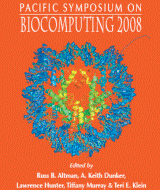Using DNA Duplex Stability Information for Transcription Factor Binding Site Discovery
Raluca Gordân, Alexander J. Hartemink
Duke University, Dept. of Computer Science,
Box 90129, Durham, NC 27708, USA
E-mail: {raluca,amink}@cs.duke.edu
Pac Symp Biocomput. 2008;:453-464.

Abstract
Transcription factor (TF) binding site discovery is an important step in understanding transcriptional regulation. Many computational tools have already been developed, but their success in detecting TF motifs is still limited. We believe one of the main reasons for the low accuracy of current methods is that they do not take into account the structural aspects of TF-DNA interaction. We have previously shown that knowledge about the structural class of the TF and information about nucleosome occupancy can be used to improve motif discovery. Here, we demonstrate the benefits of using information about the DNA double-helical stability for motif discovery. We notice that, in general, the energy needed to destabilize the DNA double helix is higher at TF binding sites than at random DNA sites. We use this information to derive informative positional priors that we incorporate into a motif finding algorithm. When applied to yeast ChIP-chip data, the new informative priors improve the performance of the motif finder significantly when compared to priors that do not use the energetic stability information.
[Full-Text PDF] [PSB Home Page]